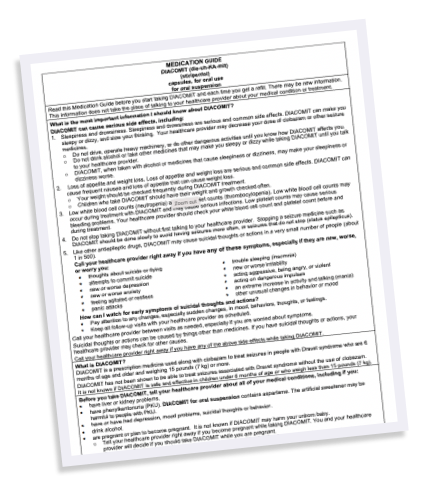
Starting DIACOMIT
Up to this point, your child may have tried several antiepileptic therapies to get their seizures under control. We know that starting another new treatment can be stressful, but there is also hope. With DIACOMIT® (stiripentol), profound seizure reduction is possible, so your family can spend more time celebrating everyday wins.
Getting Started
Caring for a child with Dravet syndrome can be overwhelming sometimes. You’re not alone in feeling that way. It can take time to find the right balance of medications, understand triggers, and develop a routine that works. When you’re ready to make the DIACOMITment, you’ll have dosing options and various resources available to support.
What To Expect With DIACOMIT
Dosing
DIACOMIT comes in two strengths: 250 mg and 500 mg. Your doctor will prescribe the appropriate dose for your child.
Forms
DIACOMIT is available in two convenient dosing forms: capsules or fruit-flavored powder for oral suspension.
Storage
Both capsules and powder forms can be stored at room temperature (68°F – 77°F), making it easy to take DIACOMIT with you when you’re on the go.
Timing
Give the prescribed dose around the same time each day for the best results. By tying it to a daily routine, you can avoid missing a dose.
How To Take DIACOMIT
DIACOMIT should be taken as prescribed by your child’s doctor. You’ll give DIACOMIT to your child two or three times a day with a meal. If your child misses a dose, DIACOMIT can be taken as soon as you remember. However, if it is almost time for the next scheduled dose, your child should skip the missed dose. Do not give two doses of DIACOMIT at the same time.


Review the DIACOMIT Medication Guide and Instructions for Use
Before preparing your child’s first dose of DIACOMIT and each time you get a refill, please review the DIACOMIT Medication Guide and Instructions for Use.
Managing Side Effects
When starting any new medication, it is important to tell your child’s doctor about any side effects your child experiences. The most common side effects for patients treated with DIACOMIT are sleepiness, decreased appetite, decreased weight, agitation, impaired coordination, decreased muscle tone, nausea, tremor, slurred speech, and trouble sleeping.1
The good news is that most side effects can be managed, and a few even reversed, through dose adjustments of certain other medications. Your child’s doctor may need to modify your child’s treatment plan and ask you to monitor for improvements.
These are not all the risks for use of DIACOMIT. Please see the Important Safety Information and full Prescribing Information. To report suspected adverse reactions, contact Biocodex at 866-330-3050 or the Food and Drug Administration at 800-FDA-1088 or www.fda.gov/medwatch.
How To Access Treatment
Learn about programs and services that make accessing DIACOMIT as easy as possible.
Dravet Syndrome and DIACOMIT Resources
Access tools and resources created to support patients with Dravet syndrome and their caregivers.

